Menus
- A comparison of three Italian motorcycle classics
- Benelli 500 Quattro (1974-1980)
- Moto Guzzi V 50 Monza (1980-1983)
- Moto Morini 3½ Sport (1974-1980)
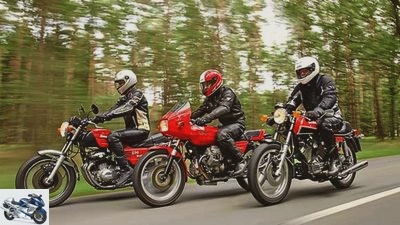
Rivas
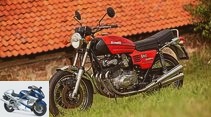
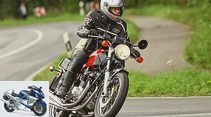
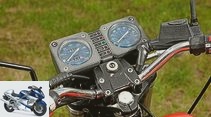
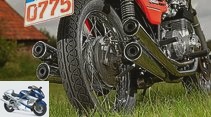
16 photos
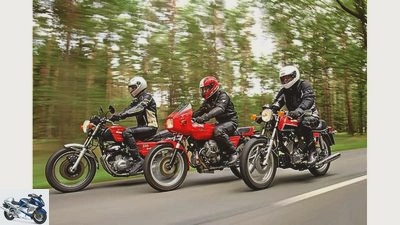
Rivas
1/16
Three Italian motorcycle classics: Moto Guzzi V 50 Monza, Moto Morini 3 ½ Sport and Benelli Quattro 500 in comparison.

Rivas
2/16
Benelli 500 Quattro.
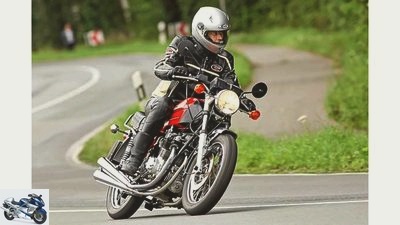
Rivas
3/16
The Quattro requires a little effort in alternating curves, but rewards it with stability and accuracy.
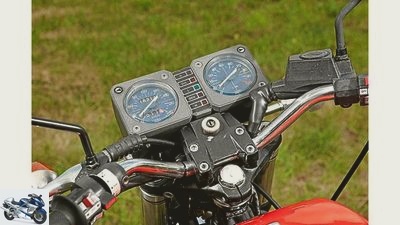
Rivas
4/16
Actually, the Benelli workplace offers everything you need. Nevertheless, its appearance requires getting used to.
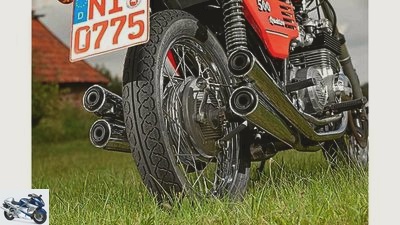
Rivas
5/16
Copy? The Honda CB 500 Four also has a four-in-four exhaust system, but it delivers less sound.
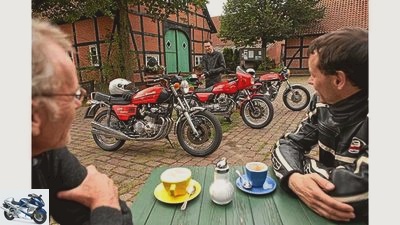
Rivas
6/16
Typically Italian, the three not only deliver stories, but also history.
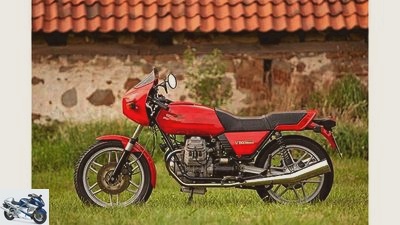
Rivas
7/16
Moto Guzzi V 50 Monza.
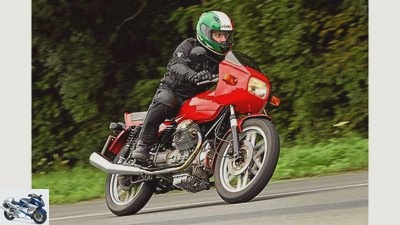
Rivas
8/16
A harmoniously designed workplace and great handling determine how the V 50 Monza is used.
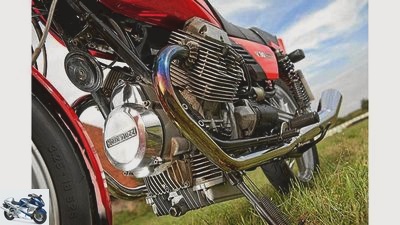
Rivas
9/16
When viewed in light, Lino Tonti’s little V2 is a successful construction. But it would have deserved a more discreet e-starter.
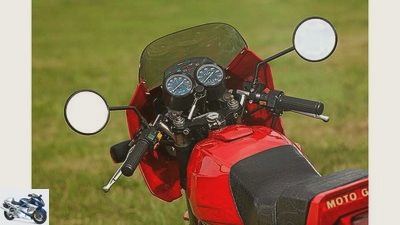
Rivas
10/16
Like the early Le Mans, the Monza also has handlebar fairing. It envelops a functional cockpit.
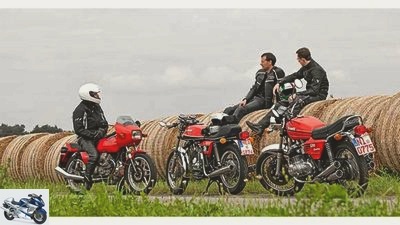
Rivas
11/16
Italian motorcycles cut a fine figure on country roads, but also on the roadside.
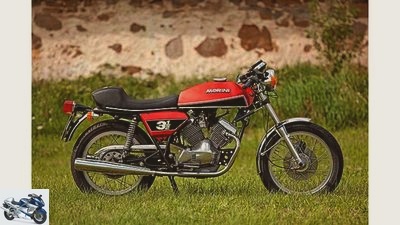
Rivas
12/16
Moto Morini 3 ½ sport.
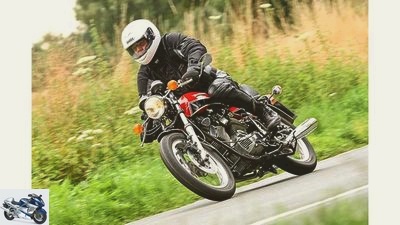
Rivas
13/16
The Morini is a wonderful lightweight, its balanced and manageable chassis allows you to always use this advantage.
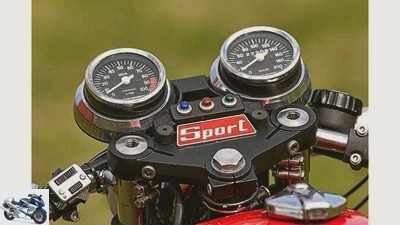
Rivas
14/16
Fits: classically designed round instruments and indicator lights. The filigree switches also have their downsides.
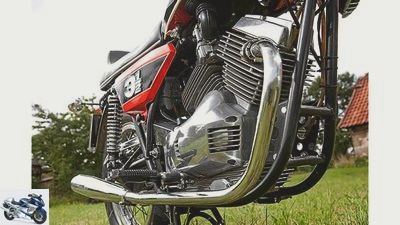
Rivas
15/16
Well ventilated, the alternator rotates behind the right side cover, as does the toothed belt to the camshaft.
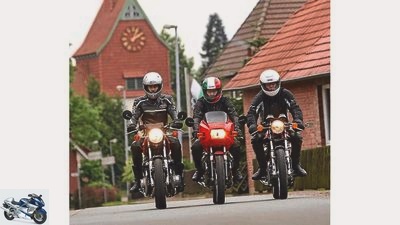
Rivas
16/16
Benelli 500 Quattro, Moto Guzzi V 50 Monza and Moto Morini 3½ Sport.
Benelli 500 Quattro, Moto Guzzi V 50 Monza and Moto Morini 3½ Sport
A comparison of three Italian motorcycle classics
Content of
Italian manufacturers have never been able to resist the thrust of the common people. So they built fine athletes for everyone. Moto Guzzi V 50 Monza, Moto Morini 3 ½ Sport and Benelli Quattro 500 for example.
With common designer wisdom such as “Form follows function” you don’t even bother mopeds and scooters on the Apennines. Nevertheless, it would be unfair to reduce the Italian motorcycle industry to the desire for the beautiful shape. Technical pioneering spirit and experience in mechanical engineering are not inferior to aesthetic efforts, and only then does the joy of the constructions from Mandello, Bologna or Pesaro become round. This is where they get their emotional appeal – especially in the small displacement classes.
Of course, a Morini 3½ Sport is nice. But it is also a technology carrier. Just like the Moto Guzzi V 50 Monza, it’s hard to believe. And Benellis Quattro? Italy’s answer to Hondas Fours was more typical of the country than its inline four-cylinder reveals. Here an exciting trio comes up, not from the dream world of MV Agusta 800 S America or Laverda 1000, but taken from the middle of life. And deliberately chosen in this constellation, because the also available 350s from Benelli and above all Guzzi offered much less performance at a slightly lower price and therefore failed in Germany. Strangely enough, the same applies to Morini’s 500, which may be a few more horsepower than its little sister, but looks much more sleepy.
As befits Italian motorcycles, the three not only deliver stories, but also history. For example, that engineer Lambertini – he had previously worked at Ferrari – resorted to the ideas of the American Samuel D. Heron for his 350cc Morini engine: In the interests of good swirling of the fuel-air mixture, he banished the combustion chamber completely to a suitably shaped one Well in the piston. The Formula 1 engine with which Jack Brabham and Dennis Hulme became world champions in 1966 and 1967 relied on this principle. It allows the valves to be arranged in parallel and therefore to save space. The cylinder angle of 72 degrees guarantees adequate mass balancing, saves a lot of installation length compared to the 90 degree angle and offers just enough space in the V-cut for the carburetor and intake manifold as well as the camshaft driven by a toothed belt.
Zwhite, three energetic kicks on the kickstarter on the left bring Lambertini’s construction to life. The engine warms up with a wonderful rumble, and the levers of the cold start devices can soon be thrown back. Enthusiasm spreads: Nobody needs more than a little Morini when standing. 750 twins do not sound fuller, more determined and healthier either. First course? Right, down. Apply gas. The Dellortos bravely raise their rectangular throttle valves. The dry clutch engages somewhat abruptly, and the V2 revs up cleanly from low speeds.
The Quattro is enough to press the button. Sure, because its engine is similar to that of the Honda CB 500 Four down to the spacing of the housing cover screws. Many still resent him today, but they should take the rough, almost aggressive sound as an announcement that the Benelli is different from the Far East goods of the time. You need a gripping hand so that the clutch disengages; first gear engages cleanly but crisply. A little speed, a little noise, that’s how it rolls off the yard.
The Moto Guzzi is the youngest of the three 1970s designs. At that time, the traditional company from Lake Como, like Benelli, belonged to the empire of Alessandro de Tomaso. The industrialist with Argentine roots set out at the beginning of the decade to stand up to the Japanese. The historical significance of this plan and its failure have not really been dealt with so far. What if the Europeans had created a real counterbalance 40 years ago? Today they are stealing market shares from the Big Four in all European countries. At that time, de Tomaso failed due to poor marketing, unconventional design and small inadequacies. Switches, for example: the fittings on the Guzzi look playful and wobbly.
But it starts reliably and enriches the air with brand-typical sound. Reliable, brave, like a big V7, only a little quieter, more contemporary. With her too, the combustion chambers in the piston crowns, based on the Heron principle, were probably fashionable back then. But the gain in space is even more noticeable than with the Morini: tall people can hardly believe their luck – their knees don’t even touch the cylinder heads. On a V2 Guzzi! The 90-degree V2 is a full 40 centimeters wide. It is connected to the locked gearbox via a neatly adjustable single-disc dry clutch. The first snaps deep down, but it snaps cleanly. The tilting moment of the longitudinal crankshaft pushes the Monza gently to the side, then it thunders out onto the country road.
The highway, yes. In its original sense of the word. So not ten meters wide and rolled over the hills as flat as a flat top. No, in a more or mostly less well cared-for condition, following the conditions of the topography. This is exactly where Italian territory opened up 40 years ago. Only third-order streets allow statements about the quality of the Italo chassis of the time. Take Benelli, for example: If you invest a morning and three hundred, you get a fork that is slightly more appealing and softer struts. So equipped, your chassis could be a child of the late 90s. Precise, incredibly stable, honest. Only in alternating curves, there she cannot deny her many pounds and – always with a full tank – quite high center of gravity.
Rivas
Benelli 500 Quattro, Moto Guzzi V 50 Monza and Moto Morini 3½ Sport.
The lightest in the field is different. The more changes in direction there are, the more comfortable the Morini feels. She can go straight ahead too, of course. But their steering behavior, their cornering stability, their handling are downright inspiring. In good condition, the Marzocchi fork is a real pleasure, ironing smoothly where many Japanese parts of this time buck, works with successful progression where those go on block. Frosted with Bridgestone’s famous BT 45, the tre e mezzo is really cocky.
This pairing also belongs to a Guzzi Monza, which is known to be very sensitive to unsuitable tires. Even handier than the Morini, it proves to be not quite as stable on bends on undulating ground. On level asphalt, she then draws the radii again, as if done with a compass. Her engine pounds smoothly out of tight bends, you quickly get used to the long gearshifts, the V2 always keeps somewhere between 3000 and 6500 revolutions. He doesn’t need more than that, and he doesn‘t like much more. Only a modern electronic ignition, insiders claim, makes it more agile at the top.
The Morini shows a little more temperament. Her V-Twin turns more freely, steps up a bit more energetically in the lower rev range. Amazingly energetic in comparison, because it covers a displacement shortfall of 150 cm³, and for this it uses, among other things, a very well graded, but not always very easy to shift six-speed gearbox. Nevertheless: The Morini is a blender. Anyone who listens to their unbelievably full sound forgets space and time. Greedy slurping from the small airbox, energetic rumbling, then angry blasting from the silencers occupy the senses, make the mind quick. The speedometer must go wrong, the tachometer lie. Only when you look in the small rearview mirror does reality catch up: the others are still there.
The Benelli, it must be said so mercilessly, can even pass easily. With a short secondary gear ratio, it makes the most of its herd of horsepower, and the significantly wider rev range that can be used compared to the Twins makes overtaking easier anyway. Above 7500 rpm the rough sound turns into angry screeching, there are still 2000 tours until the warning range begins in the rev counter. The last town is far away, so Hahn is completely open, up into fourth gear, connection again at 7000 rpm, past Morini and Guzzi, then – like a flash of lightning – the realization: de Tomaso was right. Yes, damn it, with the resources at the time and given the customer interests of the time, it had to be a four-cylinder.
Back then. When nobody except Honda had a mid-range foursome and when the guys really wanted to be in front. Today they arrive at the ice cream parlor half a minute later, jack up their V-Twins, take off their helmets and grin. Ordered three cappuccini, then the historical briefing begins. The eyes wander pleasantly over the softly crackling motorcycles. The four-cylinder topic is through, half a minute. And the dimensions of the Benelli? They can be explained by de Tomaso’s common parts strategy: two years after the Quattro, he also installed the Sei in the same chassis. The design? Well, the Japanese were round, so he tried square.
His decision to have a small V series developed by Guzzi deserves praise. The own unsuccessful attempts to sell Benelli models under the sign of the eagle prove it. Engineer Lino Tonti seized the opportunity and modernized what had been annoying him for a long time. The motor housing is divided horizontally, the swing arm is mounted in the gear housing, the frame integrates the motor as a load-bearing element. Tonti wanted to prove how compact a Guzzi can be with its engine with a longitudinal crankshaft. Very compact.
Morini, however, had to go the other way. The range of models ranged from 50 to 175 cm³ with which the manufacturer, which was quite successful in cross-country sport, had kept its head above water. But the motorcycle boom aroused needs, especially in Italy, which was until then so modest in cubic capacity. A 350cc was the ideal, because the state’s import ban extended up to this cubic capacity, newcomers between 18 and 21 years of age were only allowed to enter up to 350 cm³.
With the 3 ½ Morini surprised the mostly outdated and single-cylinder Italo competition. The Heron principle promised low fuel consumption, the V-engine high exclusivity. These trump cards stood out, the tre e mezzo went away like sliced bread. Shortly afterwards their success was increased by the sport variant. Some think that the very touristy footrest position exposes this as a quick shot. Wrong: The manifold of the rear cylinder bends in the way of a backrest system that has been laid back.
Rivas
Italian motorcycles cut a fine figure on country roads, but also on the roadside.
When Moto Guzzi sent the V 35 and V 50 on the road, the sports segment was much narrower, which is why it took two years for the V 35 Imola to appear, and one longer for the V 50 Monza. In the best Guzzi tradition, both competed with a small handlebar cover and a perfect sporty workplace. However, disappointment caused the performance, Laverdas 500 and Ducati’s Pantah pushed at least ten more horsepower.
Strangely enough, a comparably sporty four-cylinder Benelli never appeared. Perhaps de Tomaso misjudged the importance of this segment: The fact that he considered sports activities to be superfluous and stopped the Benelli GP engagement after the fatal accident of Renzo Pasolini and Jarno Saarinen speaks for this assessment.
Enough discussed: The evening round is about final character studies, and if you are honest enough, start with yourself: How could you just dismiss the Benelli? As a copy. Why was the little Guzzi only ever measured by the lack of performance compared to other 500s? And why is there no substitute for displacement??
Down with the regulars’ sayings, joy in power: the Benelli barks off, its spontaneously reacting Quattro makes it a bundle of energy, its brakes underline sporting ambitions. On long straights, however, the large tank, long seat and stable chassis even awaken wanderlust. The Guzzi sings the song of relaxed reliability with a brave baritone, and can even keep this promise. The low-maintenance cardan shaft and the integral brake system, in which the foot pedal effectively activates a front and rear brake disc, make it particularly user-friendly. Its straight lines and the small lamp cover may raise expectations a little too high, but what the heck: super handy, it scurries after the Benelli.
The Morini follows casually. A robust construction from a small but fine company, adorned with components from well-known Italian suppliers, at the same time reduced to the essentials: something for connoisseurs. But by no means something for the museum, because the sporty potential of its chassis and the steady power delivery of its V-Twin are as impressive as ever. In addition, there is still the democratic mandate: the people have a right to hear a 3½ every now and then.
The people are grateful that the Italians alone offered alternatives to the Japanese middle class in the 1970s. Under the old Roman motto panem et circenses, they combined acceptable prices and high benefits with beautiful shapes, unusual constructions and great sound. Bread and games – people don’t want more…
Benelli 500 Quattro (1974-1980)
Rivas
Benelli 500 Quattro.
Price 1975: 6695 marks
technology
Immediately after Alessandro de Tomaso had taken over Benelli in 1972, he ordered a development team from Pesaro to his company headquarters in Milan and dictated the construction of a four-cylinder series from 250 to 500 cm³ and – in perspective – a six-cylinder derived from it. For this reason, the Quattro 500, which was sold from 1974, got virtually the same chassis as the 750 series. The tank volume is also identical – 22 (later 20) liters guarantee an enormous range for the rather frugal 500. Accordingly, the Quattro was also significantly heavier than its rival, the Honda CB 500 Four. Although Benelli had already gained a lot of four-cylinder experience with racing machines, the Quattro engine can be viewed as an unabashed copy of the CB 500 engine – and almost exactly achieved its level of performance. Initially, the Quattro trusted a double simlex drum brake, but in 1976 a Brembo single-disc brake found its way into the company’s own fork. Because the recordings were available, many owners upgraded to double discs. Both chassis and brakes were superior to those of the Honda, unfortunately the quality of equipment and workmanship did not reach Japanese standards. With a higher price and a much lower workshop density, the Benelli’s chances were limited.
Used check
Somehow the heavy weight of the Quattro pays off: it is extremely solid in its substance. Among other things, crankshafts and camshafts with slide bearings and the connecting rod feet with slide bearings ensure that the engine can achieve mileages of 100,000 kilometers and more. The gearbox should be shiftable properly, otherwise the shifting claws and forks may not be in order. The standard timing chain tensioners suffer from age-related fatigue and can break – so they should be replaced with new parts made from better plastic. The rust gnaws at the folded mufflers of the four-in-four exhaust system, which is why they have been replaced on many of the models. Thanks to Wilfried Blothe’s huge warehouse (see specialists), the spare parts situation for the Quattro is relaxed, only the double-folded mudguards are rare.
market
Four-cylinder Benellis of the de Tomaso era are offered again and again, including 500s. Stylistically, the rare 354 and 504 Sport stand out with their crouched line, the eccentric 254 plays in a different league. For tourists, however, the normal versions are really good youngtimers, and it is worth taking a look at the later 654 (with a good 600 cm³ displacement). However, all these motorcycles are unlikely to achieve the collector status of a Morini 3 ½ Sport or a Honda CB 500 Four, and that should also be reflected in the price. Anyone who spends 3000 euros should get a well-maintained, largely original vehicle with 30,000 to 50,000 kilometers, original pieces with fewer kilometers on the Veglia speedometer can cost a few hundred more, a top Quattro with drum brake can also cost 5000 euros.
Specialists
Benelli-Bauer / Wilfried Blothe
Mardorfer Strasse 23-25
31547 Rehburg-Loccum
www.benelli-bauer.de
Clubs and forums
Benelli IG
www.benelli-ig.de
Data
Engine:
Air-cooled four-cylinder four-stroke in-line engine, one overhead camshaft, two valves per cylinder, operated via rocker arms, displacement 498 cm³, output 44 hp at 8500 rpm
Power transmission:
Multi-disc oil bath clutch, five-speed gearbox, chain drive
Landing gear:
Double loop frame with single-tube backbone made of steel, telescopic fork at the front, Ø 38 mm, two-arm swing arm made of tubular steel, two spring struts, wire-spoke wheels, tires 3.50 x 18 at the front, 4.10 x 18 at the rear, single-disc brake at the front, drum brake at the rear
Mass and weight:
Wheelbase 1420 mm, weight with a full tank of 230 kg
Driving performance:
Top speed 173 km / h lying down
Moto Guzzi V 50 Monza (1980-1983)
Rivas
Moto Guzzi V 50 Monza.
Price 1980: 6,990 marks
technology
The V 35 and V 50 introduced in 1977, designed like the epoch-making V7 Sport by Lino Tonti, brought some notable modernizations. For example Heron combustion chambers, thanks to which the cylinder heads are more compact – and create space for the driver’s knees. Then a light metal swing arm mounted in the gearbox housing and a frame that integrates the motor in a load-bearing manner and whose beams can be removed for the purpose of easier motor disassembly. Finally, a horizontally divided motor housing, which not only makes it easier to repair, but also makes production easier. The Monza appeared in 1980, parallel to the third evolutionary stage of the basic model. In order to improve manners in stop and go as well as during hot starts, electronic ignition was converted back to contact-controlled ignition. Larger valves and carburettors, as well as other control times, raised the output from a modest 39 to a nominal 49 hp. Technically, the Monza differs from the V 50 III in that it has a longer gear ratio.
Used check
Carelessness clouded the fundamentally high mechanical qualities of the little Guzzi. Valve springs that were too hard often resulted in the valves tearing off or the cam profiles running in. The springs installed from the mid-90s work perfectly. The sliding piece in the cardan drive must be greased regularly, and the swing arm must be horizontal when filling the final drive housing, otherwise the oil level is too low. Attention: The swing arm of the Monza is more inclined than that of the normal V 50 because of the longer suspension struts. A modern electronic ignition increases the engine speed significantly. By the time the Monza was introduced, the quality of paint and chrome parts had improved significantly. For this reason alone, it is difficult to find a specimen in its original condition.
market
The overall good supply of spare parts and its robust construction make the Monza interesting. They are also quite easy to maintain. However, the stock in Germany is only a good 200 pieces – and in Italy the smaller, but much weaker V 35 Imola was sold significantly better. While the Morini 3 ½ Sport have almost always ended up in the hands of enthusiasts, some Monza still eke out a shadowy existence. Which does not prevent some providers from proliferating with the name Moto Guzzi and calling up dream prices for tinkered copies. A good restoration base can cost 1500 to 2000 euros. For 3500 euros, the “little things” mentioned above should all be eliminated, the entire technical condition good and the optics acceptable.
Specialists
Guzzi e piu / Martin Hagemann
Wittumstrasse 18
76707 Hambrucken
www.guzziepiu.de
At the link www.larioclub.de/Problemzonen.pdf, Martin Hagemann has listed the most important problems – and their elimination – of all the little Guzzis in a very clear and understandable way
Clubs and forums
www.guzzisti.de
www.guzziworld.ch
Data
Engine:
Air-cooled two-cylinder four-stroke 90-degree V-engine, an underneath camshaft, two valves per cylinder, operated via bumpers and rocker arms, displacement 496 cm³, output 49 hp at 7600 rpm
Power transmission:
Single-disc dry clutch, five-speed gearbox, cardan drive
Landing gear:
Double loop frame made of tubular steel, telescopic fork, Ø 31.7 mm, two-arm swing arm made of cast light metal, two spring struts, cast light metal wheels, tires 3.25 x 18 front, 3.50 x 18 rear, double disc brake front, Ø 230 mm, disc brake rear, Ø 230 mm, integral Braking system
Mass and weight:
Wheelbase 1410 mm, weight with a fully fueled tank 181 kg
Driving performance:
Top speed 174 km / h lying down
Moto Morini 3½ Sport (1974-1980)
Rivas
Moto Morini 3 ½ sport.
Price 1975: 5200 marks
technology
The passionate and pragmatic engineer Franco Lambertini not only fitted his Morini V2 with Heron cylinder heads, but also – for the first time in series motorcycle production – a toothed belt as a camshaft drive. This saves weight and reduces noise. The electronic ignition developed by Ducati Elettrotecnica and an electromagnetically controlled fuel tap were also introduced, the six-speed gearbox was at least a rarity. Compared to the already quite powerful engine of the touring model, the performance of the Sport increased again thanks to increased compression and sharper camshaft. Nevertheless, it was homologated in Germany with only 28 hp – a value that the measured top speed clearly contradicts. The sport made its debut with a Grimeca double simplex brake, which was not inferior to a disc brake in its effect, but was very much in terms of controllability. As a result, a rather blunt disc brake from the same manufacturer worked in front from 1976. A year later, fashionable cast wheels replaced the wire-spoke wheels with the Borrani high-shoulder rims. Inside the engine, one of the few weak points was eliminated because the crankshaft now rotated to the right in a slide instead of a ball bearing. On request, the manufacturer supplied an electric starter from this model year.
Used check
Unlike Moto Guzzi, Morini’s experience with the electronic ignition was quite good, which is why it is still used in most 3 ½ sports today, but often with improved pickups. Timing belts of different lengths due to manufacturing tolerances required differently dimensioned camshaft gears (marked with A, B or C) to ensure the necessary belt tension. The belts must be changed every 20,000 kilometers and / or at least every three years. The oil circuit of the solid engine has to do without a fine filter as standard. No problem if the oil was changed at least every 5000 kilometers. Otherwise the oil sludge holes in the crankshaft can become clogged.
market
As with any 35-year-old motorcycle, whoever buys a 3 ½ must expect a lot. Rarely, however, with major damage. The 3 ½ sport as the most popular Morini is not a rarity. Therefore, even for a very good example from the early, particularly popular model years, the price should not exceed 4500 euros. Later models with disc brakes and cast wheels, even in good condition, are traded for between 2000 and 3000 euros. A copy in this price range should come up with the usual improvements to the ignition and a fresh timing belt. Likewise with usable struts – specimens from Ikon have proven to be the most sensible replacement.
Specialists
Wolfgang Tritsch
Schwabenmatten 7
79292 Pfaffenweiler
www.w-tritsch.de
Dieter Hoffmann
Birkenstrasse 19
74834 Elztal-Dallau
www.morinicorse.com
Werner Wilhelmi
Baderstrasse 13
56357 Holzhausen
Clubs and forums
www.ital-web.de
Data (model 1976)
Engine:
Air-cooled two-cylinder, four-stroke, 72-degree V-engine, an underneath camshaft, two valves per cylinder, operated via bumpers and rocker arms, displacement 344 cm³, output 28 hp at 6850 / min
Power transmission:
Multi-disc dry clutch, six-speed gearbox, chain drive
Landing gear:
Double loop frame made of tubular steel, telescopic fork, Ø 35 mm, two-arm swing arm made of tubular steel, two spring struts, wire-spoke wheels, tires 3.25 x 18 at the front, 4.10 x 18 at the rear, single-disc brake at the front, drum brake at the rear
Mass and weight:
Wheelbase 1400 mm, weight with a full tank of 158 kg
Driving performance:
Top speed 174 km / h lying down
Related articles
-
Comparison test of two-cylinder: Ducati 750 Sport, Laverda 750 SF and Moto Guzzi 750 S
29 pictures 1/29 Twin and away: The Ducati 750 Sport, Laverda 750 SF and Moto Guzzi 750 S in a comparison test. 2/29 Your …
-
Classic: Moto Morini 3 1-2 Sport
Classic Moto Morini 3 1/2 Sport He was beautiful anyway. And technically, Morini’s little twin fits seamlessly between those from Ducati and Moto Guzzi ….
-
Benelli, Buell, Moto Guzzi and Moto Morini
Moto Morini 6 pictures Moto Morini 1/6 The Moto Morini Granpasso 1200 is clearly aimed at BMW. Moto Morini 2/6 The Moto Morini Granpasso 1200 aims …
-
Comparison test of naked bikes BMW R 1150 R Moto Guzzi V11 Sport Voxan Scrambler
Jahn comparison test naked bikes BMW R 1150 R Moto Guzzi V11 Sport Voxan Scrambler We are so three Born out of tradition and self-confidence, roll …
-
Comparison test Ducati Monster 900 i.e, Moto Guzzi V11 Sport Scura, Yamaha BT 1100 Bulldog
Gargolov comparison test Ducati Monster 900 i.e, Moto Guzzi V11 Sport Scura, Yamaha BT 1100 Bulldog Tingling in the stomach Three very different twins with …
-
Top test Moto Guzzi 1200 Sport 4V
fact top test, Moto Guzzi 1200 Sport Moto Guzzi 1200 Sport 4V Moto Guzzi has not only been in crisis since the crisis. In the identity crisis. Classic …
-
39 pictures 1/39 The Triumph Speed Triple: The price 11,740 euros (the test motorcycle with windshield for 245 euros and …
-
Driving report Moto Guzzi V11 Sport
Driving report Moto Guzzi V11 Sport 11 after 7 Finally there and finally classic again: the V11. With it, a new era should begin at Guzzi. Don’t panic,…
-
Driving report Moto Guzzi 1200 Sport
Artist Driving report Moto Guzzi 1200 Sport Long live the sport Since Moto Guzzi has been under the wing of Aprilia and thus ultimately Piaggio, the…
-
Famous motorcycles: Moto Guzzi 850 Le Mans
Gori Famous motorcycles: Moto Guzzi 850 Le Mans When eagles still flew, eagle wings are majestically emblazoned in the Moto Guzzi logo. At the time of the 850 Le …